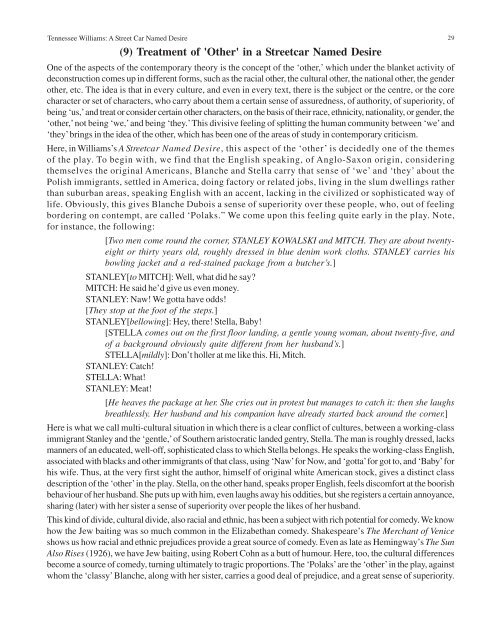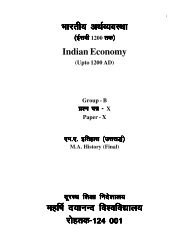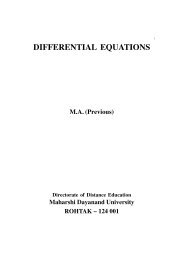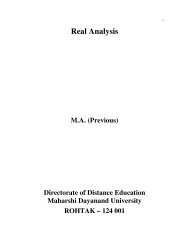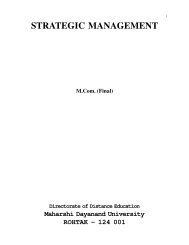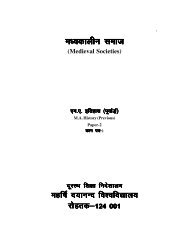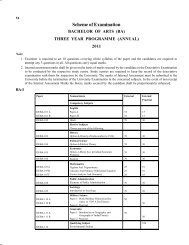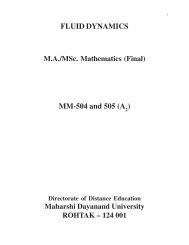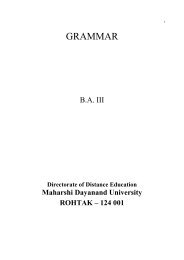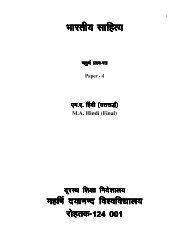LITERATURE AND GENDER - Maharshi Dayanand University, Rohtak
LITERATURE AND GENDER - Maharshi Dayanand University, Rohtak
LITERATURE AND GENDER - Maharshi Dayanand University, Rohtak
You also want an ePaper? Increase the reach of your titles
YUMPU automatically turns print PDFs into web optimized ePapers that Google loves.
Tennessee Williams: A Street Car Named Desire(9) Treatment of 'Other' in a Streetcar Named DesireOne of the aspects of the contemporary theory is the concept of the ‘other,’ which under the blanket activity ofdeconstruction comes up in different forms, such as the racial other, the cultural other, the national other, the genderother, etc. The idea is that in every culture, and even in every text, there is the subject or the centre, or the corecharacter or set of characters, who carry about them a certain sense of assuredness, of authority, of superiority, ofbeing ‘us,’ and treat or consider certain other characters, on the basis of their race, ethnicity, nationality, or gender, the‘other,’ not being ‘we,’ and being ‘they.’ This divisive feeling of splitting the human community between ‘we’ and‘they’ brings in the idea of the other, which has been one of the areas of study in contemporary criticism.Here, in Williams’s A Streetcar Named Desire, this aspect of the ‘other’ is decidedly one of the themesof the play. To begin with, we find that the English speaking, of Anglo-Saxon origin, consideringthemselves the original Americans, Blanche and Stella carry that sense of ‘we’ and ‘they’ about thePolish immigrants, settled in America, doing factory or related jobs, living in the slum dwellings ratherthan suburban areas, speaking English with an accent, lacking in the civilized or sophisticated way oflife. Obviously, this gives Blanche Dubois a sense of superiority over these people, who, out of feelingbordering on contempt, are called ‘Polaks.” We come upon this feeling quite early in the play. Note,for instance, the following:[Two men come round the corner, STANLEY KOWALSKI and MITCH. They are about twentyeightor thirty years old, roughly dressed in blue denim work cloths. STANLEY carries hisbowling jacket and a red-stained package from a butcher’s.]STANLEY[to MITCH]: Well, what did he say?MITCH: He said he’d give us even money.STANLEY: Naw! We gotta have odds![They stop at the foot of the steps.]STANLEY[bellowing]: Hey, there! Stella, Baby![STELLA comes out on the first floor landing, a gentle young woman, about twenty-five, andof a background obviously quite different from her husband’s.]STELLA[mildly]: Don’t holler at me like this. Hi, Mitch.STANLEY: Catch!STELLA: What!STANLEY: Meat![He heaves the package at her. She cries out in protest but manages to catch it: then she laughsbreathlessly. Her husband and his companion have already started back around the corner.]Here is what we call multi-cultural situation in which there is a clear conflict of cultures, between a working-classimmigrant Stanley and the ‘gentle,’ of Southern aristocratic landed gentry, Stella. The man is roughly dressed, lacksmanners of an educated, well-off, sophisticated class to which Stella belongs. He speaks the working-class English,associated with blacks and other immigrants of that class, using ‘Naw’ for Now, and ‘gotta’ for got to, and ‘Baby’ forhis wife. Thus, at the very first sight the author, himself of original white American stock, gives a distinct classdescription of the ‘other’ in the play. Stella, on the other hand, speaks proper English, feels discomfort at the boorishbehaviour of her husband. She puts up with him, even laughs away his oddities, but she registers a certain annoyance,sharing (later) with her sister a sense of superiority over people the likes of her husband.This kind of divide, cultural divide, also racial and ethnic, has been a subject with rich potential for comedy. We knowhow the Jew baiting was so much common in the Elizabethan comedy. Shakespeare’s The Merchant of Veniceshows us how racial and ethnic prejudices provide a great source of comedy. Even as late as Hemingway’s The SunAlso Rises (1926), we have Jew baiting, using Robert Cohn as a butt of humour. Here, too, the cultural differencesbecome a source of comedy, turning ultimately to tragic proportions. The ‘Polaks’ are the ‘other’ in the play, againstwhom the ‘classy’ Blanche, along with her sister, carries a good deal of prejudice, and a great sense of superiority.29


